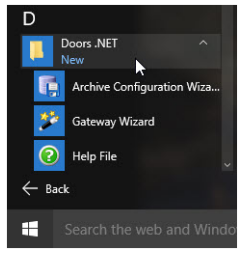Upgrading to Windows 10
1.0 Introduction
As with any operating system installation you should make a full backup of your important data (including the Doors.NET database) but this is only a precautionary step as the upgrade process retains all the original Windows files and programs. Information on detaching and attaching a Doors.NET database (the backup/restore process for Doors.NET) can be found on the Detach Attach DoorsNET Databases Application Note (p/n: 01224.001). You should also backup the entire Keri/DoorsNet folder as it may have feature information not stored within the Doors.NET database.
You should also consider verifying that all your supporting software and drivers on your PC are Windows 10 compatible prior to performing the operating system upgrade.
Once the operating system upgrade has been completed Doors.NET is ready to use.
Note: Due to the manner in which Windows 10 manages the SQL Server program, once you upgrade your operating system to Windows 10, any future Doors.NET software upgrades must be done using v3.5.1.21 software or greater. Beginning with v3.5.1.21 software, the Doors.NET software upgrade process properly manages the revision of SQL Server, updating the SQL Server software as well if needed.
| 2.0 | Upgrading From Windows 7 |
To upgrade from Windows 7 to Windows 10 you must have a fully activated, genuine copy of Windows 7. It must be updated to the latest version of Windows 7 (SP1). This is also a pre-requisite for running Doors.NET. Use the Windows Update feature if you need to update Windows 7 to SP1.
You do not need to re-install the Doors.NET software or restore the database, your Doors.NET shortcuts remain as they were in Windows 7 (for example on the Desktop and via the Start Menu).
to find ‘Doors.NET.’

Note: Windows 7 uses SQL Server version 2005 which works fine with Windows 10. But Microsoft has stated that as of 12 April 2016, Microsoft will be ending their support for SQL Server version
2005. This means there will be no more security updates or bug fixes for this SQL revision. Keri recommends upgrading to a more current version of SQL that is supported on Windows 10 for the
foreseeable future, such as Server 2012 or 2014.
| 3.0 | Upgrading From Windows 8.1 |
To upgrade from Windows 8.1 you must have a fully activated and genuine copy of Windows 8.1.
Use the Windows Update feature if you need to update from Windows 8 to Windows 8.1.
As Windows 8.1 uses either SQL Server 2012 or 2014 there really are no implications to be aware of when upgrading to Windows 10. However, we do still recommend backing up all your important data
(including the Doors.NET database) before you proceed with the operating system upgrade.
| 4.0 | Operating System End-of-Life Notifications |
| 4.1 | Windows XP |
Microsoft ended support for Windows XP 8 April 2014. Microsoft no longer provides technical support or security updates. For this reason the NEXT revision of Doors.NET (v3.5.1.22) will not be
compatible with the Windows XP operating system and cannot be installed on a computer using this operating system.
Microsoft is ending support for SQL Server 2005 as of 12 April 2016. For this reason the NEXT revision of Doors.NET (v3.5.1.22) will not be compatible with the SQL Server 2005 operating
system and cannot be installed on a computer using this operating system.
Related Articles
Windows 10 End of Support Notification
1.0 Introduction On October 14, 2025, Microsoft will end support for most versions of Windows 10. You will be able to continue using Windows 10 but most importantly, you will no longer receive important and often critical security and reliability ...Installing Doors.NET on a Windows 11 PC
1.0 Introduction Doors.NET Software is now supported on Windows 11 Operating systems. Keri has done extensive testing with Doors.NET v5.0.0 and strongly recommends installing Doors.NET v5.0.0 or higher to ensure compatibility with Windows 11. While ...What are the Steps For Upgrading a Doors32 System to Doors.NET?
Introduction This document provides the requred steps for converting a Doors32 (PXL-500) system into a Doors.NET system. Notes: PXL-250 controllers are not supported with Doors.NET The minimum firmware version for PXLs when using Doors.NET is ...Imageware Badging Issue With Windows Updates
Important Notification It has been reported that there can be issues with Imageware EPI Suite software following a Windows update. Imageware has acknowledged these issues and have issued a software patch. The documentation Imageware has provided ...SQL Server Will Not Start After Windows 11 Upgrade – NVMe Drive Compatibility
1.0 Introduction Error code 1067 most often occurs when trying to start the SQL Server Windows service after the host PC has been upgraded from Window 10 to Windows 11. This happens if an NVMe disk drive is used and the drive has a sector that's ...